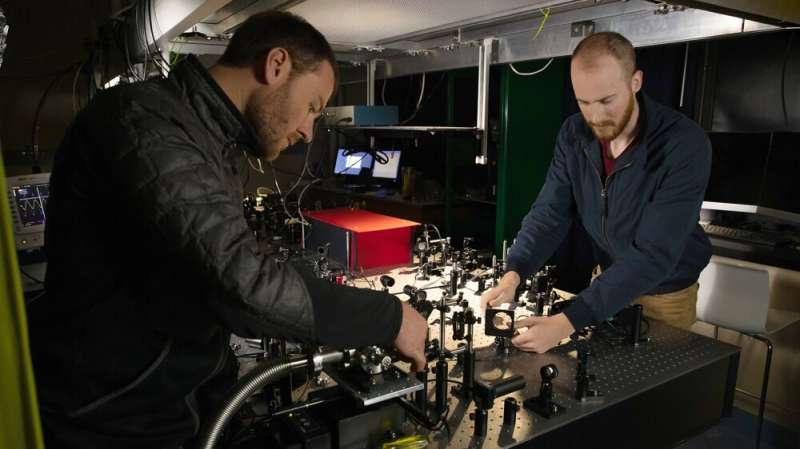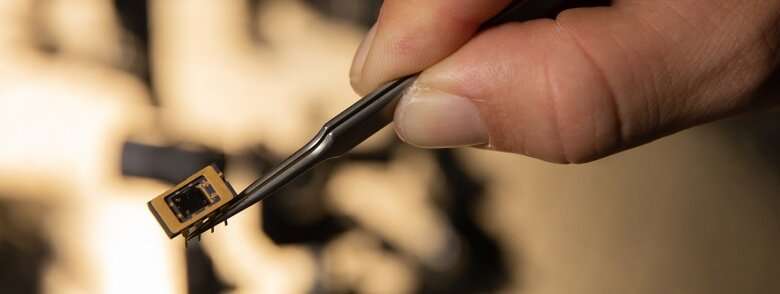Discovery leads to ultrasensistive way to measure light

A team of UO physicists has drummed up a new way of measuring light: using microscopic drums to hear light.
The technology out of the Alemán Lab, known as a "graphene nanomechanical bolometer," leverages a promising new method and material to detect nearly every color of light at high speeds and high temperatures.
"This tool is the fastest and most sensitive in its class," said Benjamín Alemán, a professor of physics and a member of the UO's Center for Optical, Molecular, and Quantum Science and an associate of the Phil and Penny Knight Campus for Accelerating Scientific Impact.
The device offers an alternative to the conventional way of using electricity to measure light, as found in devices like a smartphone's camera. Instead, this mechanical method captures the vibrations of infinitesimally thin drums that are caused by light. The physicists obtain measurements by listening to the sound of the light absorbed by the drumhead.
The way the technology works is similar to the effect of banging a drum on a hot day. As the instrument heats up under the piping sun, the drumhead membrane will expand and its pitch changes, emitting a different tone than it would at cooler temperatures.
The waves of light do the same thing to the mechanical bolometers. As light hits the device's drumhead, the membrane heats up, expands, and the vibrational pitch changes. The physicists can track these pitch changes to measure how much light hits the device.
"This is a very new way of detecting light," said David Miller, a doctoral student in the Alemán Lab. "We're using a purely mechanical method to turn light into sound. This has the advantage of being able to see a much broader range of light."
He goes on to explain that conventional detectors are very reliable at reading high-energy light, like visible light or X-rays, but less adept at measuring the longer wavelengths on the electromagnetic spectrum, including infrared and radio waves. The mechanical device fills that void and allows the physicists to detect light of nearly any wavelength, which could be especially useful in astronomical observations, thermal and medical body imaging and seeing deep into the infrared.
The team constructed the device by first stretching a thin sheet of atoms over a hole etched into a piece of silicon. Then, using a technique developed previously in the lab, they cut the sheet to resemble a trampoline—a really, really small trampoline.
The device is one-tenth the width of a human hair, while the material used for the trampoline is even smaller—a single atom thick, about a million times thinner than that same strand of hair.

"This system uses graphene, which is just a single layer of atoms. It's as small as it can be." said Andrew Blaikie, another doctoral student in the Alemán Lab and lead author on the paper, which was published in Nature Communications this week.
Graphene, a material discovered in 2004, is the key ingredient for the technology's success. It is a small, but mighty, material. Although it's the thinnest possible material, graphene is 200 times stronger than steel and extraordinarily flexible. It's discoverer even won the 2010 Nobel Prize in physics for its potential to revolutionize physics and engineering.
Graphene's mechanical properties allow the material to respond to temperature changes incredibly fast, which enables it to measure light at equally speedy rates.
"Graphene offered a tantalizing prospect for ultrasensitive and ultrafast light detection," Blaikie said. "It also possesses an unmatched ability to measure nearly any wavelength of light and can withstand much higher temperatures than conventional detectors."
The team of physicists was able to harness the powers of graphene through its mechanical approach to measuring light. While bursting with potential for light detection, the material has performed poorly through the traditional methods of using electrical resistance to measure light, mainly due to its need to be chilled to ultralow temperatures to be useful in conventional detectors.
When they realized they could turn light into sound through their mechanical method, they were able to unlock the prospects of graphene and create the ultrafast, ultrasensitive device that excels at, and far above, room temperature.
Its ability to perform at such a wide range of temperatures is one of the device's most advantageous qualities when it comes to measuring light, Blaikie explained. It can operate at room temperature, which allows for critical portability, and it can perform under high heat, which is a benefit that traditional light detectors don't offer, as many of them will fail what's known as the "sunburn effect," when they begin to break down as temperatures spike.
"Graphene is a thermally stable material that can withstand temperatures over 2,000 degrees Celsius," Blaikie said.
Its versatility and ultrasensitive nature position the nanomechanical bolometer to be a useful tool in many arenas across science, medicine, industrial manufacturing and astronomy. The Alemán Lab has a patent pending for the technology.
"We hope this device will help scientists crack the mysteries of our sun and other stars, improve medical diagnostics through safer thermal X-ray imaging, and help firefighters see better in fires to save more lives," Alemán said.
Journal information: Nature Communications
Provided by University of Oregon





















